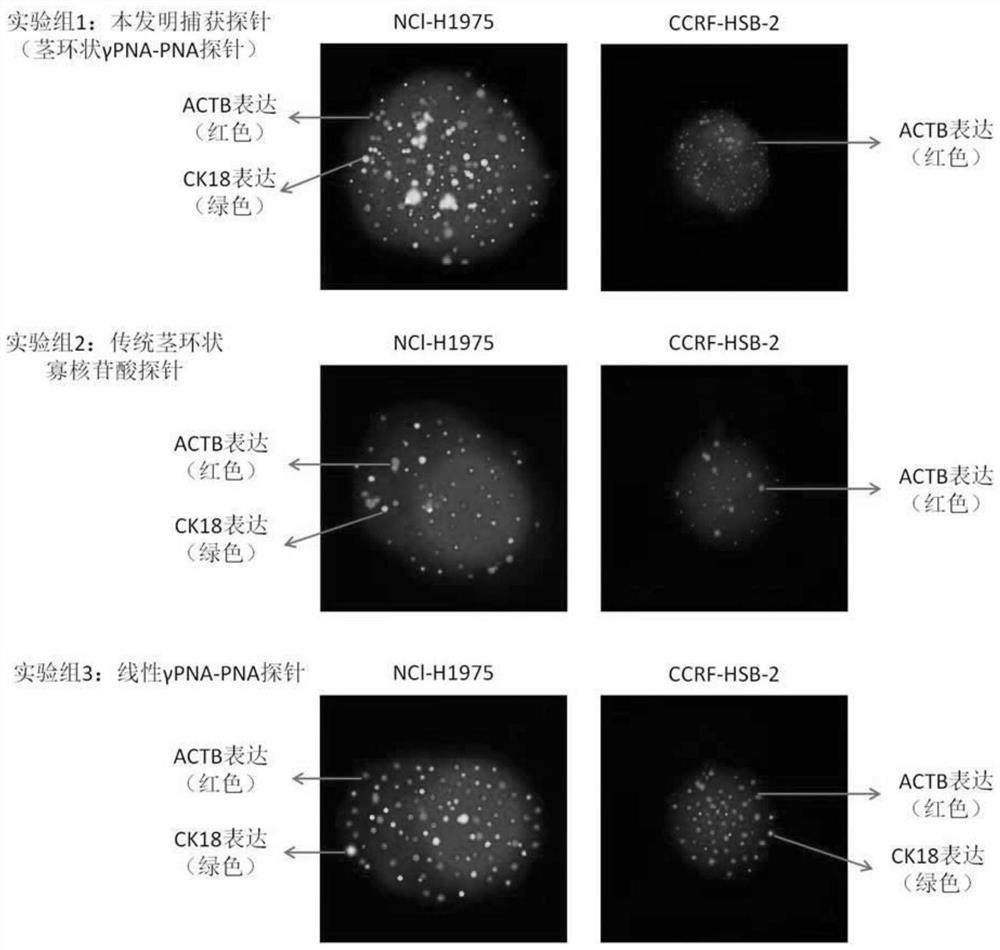Kit for detecting gene expression of cytokeratin 18
A detection kit and gene expression technology, applied in the field of molecular biology, can solve problems such as high requirements for experimental conditions, difficulty in ensuring the accuracy and reliability of detection results, and limited tissue samples required for detection, so as to improve detection Efficiency, improvement of detection effect, shortening the effect of amplification and hybridization time
- Summary
- Abstract
- Description
- Claims
- Application Information
AI Technical Summary
Problems solved by technology
Method used
Image
Examples
Embodiment 1
[0050] Embodiment 1 A kind of cytokeratin 18 gene expression detection kit
[0051] A cytokeratin 18 gene expression detection kit described in this embodiment mainly includes:
[0052] 1. Capture Probes
[0053] From the 5' end to the 3' end of the capture probe, there are a stem structure sequence, a specific P1 sequence capable of binding to the target mRNA to be detected, a linker (Linker), and a P2 sequence. The P2 sequences in the capture probes of the same target mRNA are the same. The stem sequence is a γ-modified peptide nucleic acid (γPNA) sequence with a base length of 4 to 8 bp, which can be complementary to the base at the 3' end of the P2 sequence to form a stem-loop structure; the specific P1 sequence is a base length γPNA sequence of 10-22bp; the Linker is EG 8 Linker; the P2 sequence has a base length of 8-20 bp, no hairpin structure, no dimer formation or mismatch within the probe and between probes, and no specificity between P1 and target mRNA sex-bindi...
Embodiment 2
[0081] Example 2 Using the kit described in Example 1 to detect the sample
[0082] The formula of described various solutions is as table 7:
[0083] Formulation of various solutions of table 7
[0084]
[0085]
[0086] In this embodiment, the blood samples of tumor patients are preferred, and the expression level of CK18 gene of circulating tumor cells in the samples is detected, wherein the capture mixed solution, the chromogenic mixed solution SP1, and the chromogenic mixed solution SP2 all use all of the corresponding lists described in Example 1. probe.
[0087] 1. Take 5ml of blood from the patient's vein into a vacuum blood collection tube to obtain a blood sample.
[0088] 2. Sample pretreatment, the cells to be tested are filtered onto the filter membrane.
[0089] (1) Collect the cell suspension to be tested, centrifuge at 600×g for 5 minutes, and discard the supernatant; (2) Add 4ml PBS and 1ml fixative, vortex and mix, and let stand at room temperature f...
Embodiment 3
[0111] Embodiment 3 The impact of different types of capture probes on the detection effect of the kit
[0112] 1. Design of kit preparation (capture probe design)
[0113] In order to evaluate the detection effect of kits composed of different types of capture probes, experimental groups 1-3 were designed, and each group had the same components except for the types of capture probes. The specific design is shown in Table 10.
[0114] Table 10 Selection of kit capture probes
[0115]
[0116]
[0117] 2. Sample detection
[0118] In this example, commercially available cell lines NCl-H1975 and CCRF-HSB-2 were selected for experiments. Take 3000 NCl-H1975 and CCRF-HSB-2 cells respectively (determined by a cell counter), and after mixing, divide each sample into 15 parts, numbered 1-15 and 16-30 in sequence. Using the kit prepared by the above design, samples 1 to 30 were detected according to the detection process and method described in Example 2, and 5 samples of ea...
PUM
 Login to View More
Login to View More Abstract
Description
Claims
Application Information
 Login to View More
Login to View More - R&D
- Intellectual Property
- Life Sciences
- Materials
- Tech Scout
- Unparalleled Data Quality
- Higher Quality Content
- 60% Fewer Hallucinations
Browse by: Latest US Patents, China's latest patents, Technical Efficacy Thesaurus, Application Domain, Technology Topic, Popular Technical Reports.
© 2025 PatSnap. All rights reserved.Legal|Privacy policy|Modern Slavery Act Transparency Statement|Sitemap|About US| Contact US: help@patsnap.com



